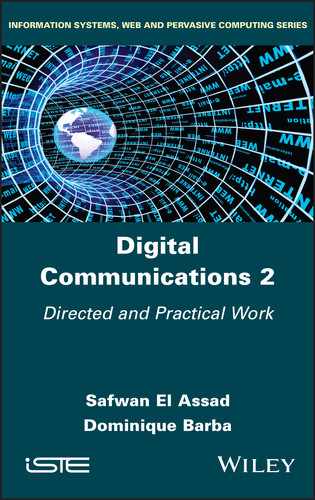It is a complete training in digital communications in the same book with all the aspects involved in such training: courses, tutorials with many typical problems targeted with detailed solutions, practical work concretely illustrating various aspects of technical implementation implemented. It breaks down into three parts. The Theory of information itself, which concerns both the sources of information and the channels of its transmission, taking into account the errors they introduce in the transmission of information and the means of protect by the use of appropriate coding methods. Then for the technical aspects of transmission, first the baseband transmission is presented with the important concept and fundamental technique of equalization. The performance evaluation in terms of probability of errors is systematically developed and detailed as well as the online codes used. Finally, the third part presents the Transmissions with digital modulation of carriers used in radio transmissions but also on electric cables. A second important aspect in learning a learner's knowledge and skills is this book. It concerns the "Directed Work" aspect of a training. This is an ordered set of 33 typical problems with detailed solutions covering the different parts of the course with practical work. Finally, the last aspect concerns the practical aspects in the proper sense of the term, an essential complement to training going as far as know-how. We propose here a set of 5 practical works.
Table of Contents
- Cover
- Title page
- Copyright
- Foreword
- PART 1: Tutorials
- 1 Theory of Information: Problems 1 to 15
- 1.1. Problem 1 – Entropy
- 1.2. Problem 2 – K-order extension of a transmission channel
- 1.3. Problem 3 – Compressed speech digital transmission and Huffman coding
- 1.4. Problem 4 – Coding without and with information compression
- 1.5. Problem 5 – Digital transmission of a TV signal (luminance component only) with information compression and Huffman coding
- 1.6. Problem 6 – Information, entropy, codes (1)
- 1.7. Problem 7 – Information, entropy, codes (2)
- 1.8. Problem 8 – Coding and transmission of a television-type information source
- 1.9. Problem 9 – Entropy and motion information encoding of multimedia source
- 1.10. Problem 10 – Hamming coding
- 1.11. Problem 11 – Cyclic coding (1)
- 1.12. Problem 12 – Cyclic coding (2)
- 1.13. Problem 13 – Cyclic coding and Hamming coding (1)
- 1.14. Problem 14 – Cyclic coding and Hamming coding (2)
- 1.15. Problem 15 – Cyclic code, M-sequences, and Gold sequences
- 2 Baseband Digital Transmission: Problems 16 to 26
- 2.1. Problem 16 – Entropy and information to signal source coding
- 2.2. Problem 17 – Calculation of autocorrelation function and power spectral density by probabilistic approach of RZ and NRZ binary on-line codes
- 2.3. Problem 18 – Calculation of the autocorrelation function and the power spectral density by probabilistic approach of the bipolar RZ code
- 2.4. Problem 19 – Transmission using a partial response linear coding
- 2.5. Problem 20 – Signal information coding and digital transmissions with partial response linear encoder
- 2.6. Problem 21 – Baseband digital transmission system (1)
- 2.7. Problem 22 – Baseband digital transmission (2)
- 2.8. Problem 23 – M-ary digital baseband transmission
- 2.9. Problem 24 – Baseband digital transmission of bipolar coded information
- 2.10. Problem 25 – Baseband transmission and reception using a partial response linear coding (1)
- 2.11. Problem 26 – Baseband transmission and reception using a partial response linear coding (2)
- 3 Digital Transmissions with Carrier Modulation: Problems 27 to 33
- 3.1. Problem 27 – Digital transmissions with carrier modulation
- 3.2. Problem 28 – 4-QAM digital modulation transmission (1)
- 3.3. Problem 29 – Digital transmissions with 2-ASK modulation
- 3.4. Problem 30 – 4-QAM digital modulation transmission (2)
- 3.5. Problem 31 – Digital transmissions with 4-QAM digital modulation: case of single and double paths propagation
- 3.6. Problem 32 – Performance of digital modulations and 16-QAM digital modulation
- 3.7. Problem 33 – QAM encoding and transmission of motion information of digital video
- PART 2: Practical Works
- 4 Study of the Transmission of Digital Information on Two-wire Cables
- 4.1. Introduction
- 4.2. Recall of essential results on transmission line theory
- 4.3. Practical study
- 4.4. Objectives
- 4.5. Measurement of the characteristic impedance Zc by a reflectometry method (Time Domain Reflectometry: TDR)
- 4.6. Measurement of attenuation α as a function of frequency
- 4.7. Variation of the attenuation α as a function of length
- 4.8. Measurement of the bitrate D (bit/s)
- 5 Study of Baseband Digital Transmission Systems for the Transmission of Analog Signals (Transmitter and Receiver)
- 5.1. Objectives
- 5.2. First part – Study of a pulse amplitude modulation and time division multiplex signal transmission system
- 5.3. Second part – Study of a pulse code modulation (PCM) signal transmission system and transmission error control (error detector code and error corrector code)
- 6 Study of On-line Codes for Baseband Modulation and Carrier Modulation
- 6.1. Objectives
- 6.2. Description of the electronic boards
- 6.3. First part – Study of on-line codes for baseband digital transmission
- 6.4. Second part – Study of digital modulations with carrier
- 7 Study of a QPSK Modem Under MATLAB, Simulink, Communications and DSP
- 7.1. Objective
- 7.2. Required work
- 7.3. Appendix: Diagrams of the QPSK modem and its different blocks
- 8 Study of a Coding and Decoding System by Cyclic Codes
- 8.1. Objective
- 8.2. Recall of the principles of cyclic coding and decoding
- 8.3. Coding by division: systematic code
- 8.4. Decoding by division: principle of calculating the syndrome
- 8.5. Required work
- 8.6. Appendix: Block diagrams
- References
- Index
- End User License Agreement
